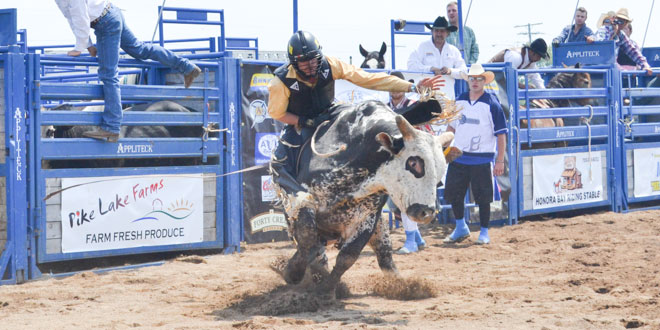The Manitoulin Rodeo, coming to the Manitowaning fairgrounds this June 28 and 29.
Rodeo is a competitive sport which arose out of the working practices of cattle herding in Spain, Mexico, and later the United States, Canada, South America, This is a two-part series to help people to understand what rodeo is in a lead up to Australia and New Zealand. It is based on the skills required of the working vaqueros and later, cowboys, in what today is the western United States, western Canada, and northern Mexico. Today it is a sporting event that consists of events that involve horses and other livestock and is designed to test the skill of cowboys and cowgirls as if they were working at large. Many but not all rodeo events were based on the tasks required by cattle ranching.
Most rodeos are comprised of time events or rough stock events.
Bareback Bronc Riding – timed event
The bareback bronc riding event shows the ability of the contestant to move his feet from the point of the shoulder back to his hand hold. His knees will almost strike his chin. The contestant only has a hand hold, which resembles that of a suitcase handle. The ride lasts for eight seconds in which time the contestants’ free hand cannot touch the animal or any part of his body. The mark out rule also must be adhered to. The contestants’ feet must be over the point of the horses shoulders when the horses feet touch the ground outside the chute. The bareback broncs are usually smaller then the saddle broncs with a lot of quick twists, sun-fishing, and turn backs in their moves. The horse and rider are judged by a two-judge system. Each judge will award a score out of 25 for both the rider and the animal giving a total score of 100.
Saddle Bronc Riding – timed event
Saddle bronc riding is called the “classic event of rodeo,” originating from the task of breaking wild horses for use on the cattle ranches of the Canadian and American west. It has since evolved for the rodeo arena and has also become one of the most complicated events for the rodeo cowboy. It involves strength, timing, and technique as the cowboy attempts to ride the bucking bronc for eight seconds holding onto only a thick rope attached to the horse halter. He only uses one hand to work the rope and keep him on the saddle as he spurs the horse and tries to time his movements with the broncs bucking in order to score high points. The scoring is also done with two judges the same as the bareback bronc.
Steer Wrestling – rough stock event
Steer wrestling, also known as “bull dogging,” is the fastest event in the arena. The bull dogger, from his galloping horse, attempts to grab a running steer (weighing between 400 and 600lbs) and wrestle it to the ground. Like the roping events the steer is given a head start and is followed by the wrestler and his hazer. The hazer is a mounted cowboy who rides along the right hand side of the steer keeping it running in a straight line. This makes the steer wrestler’s job easier when jumping from his horse. The wrestler reaches for the steer’s horns and swings his legs from behind him to in front as he tries to use the momentum of that maneuver and his strength to bring down the steer. The clock is stopped when the steer’s head, body and all four legs are on the ground. All this action can take place in less than five seconds. As with roping, penalties apply if the wrestler leaves the box too soon in pursuit of his steer.
Barrel Racing – timed event
Most rodeos have this as a women’s event. The riders will race their horses into the arena to run a cloverleaf pattern around three barrels and out again. The goal is to have the fastest time without knocking over a barrel. The rider tries to guide the horse as tightly around each barrel as close as she can to shave milliseconds off her time. A fraction of a second is all it takes to win or lose a barrel race. This sport highlights the speed and agility and training of the horse.
An electric eye connected with an electronic timer and a judge with a stopwatch record the time. The rider is given a running start into the arena and her time begins when she passes the starting line and ends when she crosses it again after running a long stretch back from the third barrel at the opposite end of the arena.
This is the first four events of our rodeo section. Please stay tuned for more information on the other events that A-K Rodeo will be bringing to Manitoulin Island as cowboys and cowgirls from all over begin their 2014 quest for top prizes. May is the start of rodeo season in our province and we look forward to inviting here for our Canada Day weekend activities. For more information see www.manitoulinrodeo.net or join our Facebook page.
See you at the rodeo!





